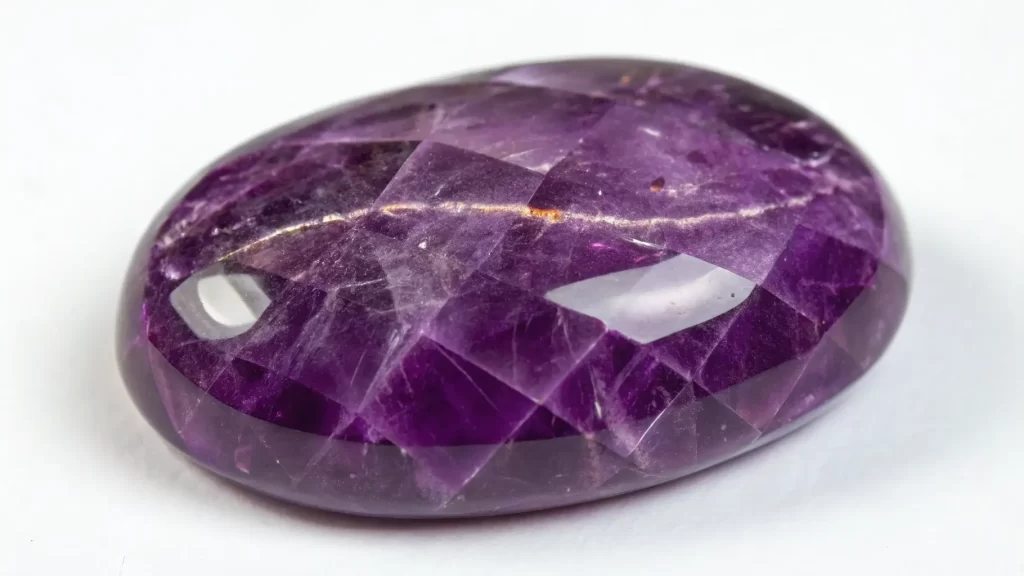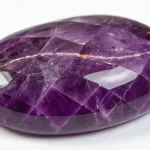
- Key Takeaways
- What is the Feb 16 Birthstone?
- The Meaning and Symbolism of Amethyst
- Where Amethyst is Found?
- The Color Spectrum of Amethyst
- Amethyst in Jewelry: A Timeless Gem for Every Style
- Caring for Your Amethyst Jewelry: A Practical Guide
- Fun Facts About Amethyst: Surprising Tidbits
- Amethyst in Astrology and Spirituality
- Conclusion: Celebrate the Power and Beauty of Amethyst
Amethyst, the beautiful February birthstone, is celebrated for its stunning purple color and meaningful symbolism. Known as a purple birthstone of clarity, peace, and spiritual growth, it has been cherished for centuries across cultures. This beautiful amethyst’s calming energy and timeless beauty make it a favorite for jewelry and a thoughtful gift for a February birthday.
This gemstone has a fascinating history, is often associated with royalty, and is believed to hold protective and healing properties. Whether you’re drawn to its vibrant hues or intrigued by its deeper meanings, amethyst is more than just a gem—it’s a connection to nature, history, and personal well-being.
In this blog, we’ll uncover the origins of amethyst, explore its symbolism, and look at how it’s used in jewelry, astrology, and daily life. By the end, you’ll see why this captivating stone continues to inspire and enchant people around the world.
Key Takeaways
Amethyst’s Meaning: Symbolizes clarity, inner strength, peace, and personal empowerment, helping the wearer remain clear-headed.
Origins: Found globally, with high-quality amethysts originating in Brazil, Zambia, and Uruguay.
Versatility: Popular in all types of amethyst jewelry, from rings to necklaces, and pairs beautifully with other gemstones.
Care: Durable yet sensitive to heat, harsh chemicals, and improper storage.
Astrological Ties: Associated with Pisces and Aquarius, and the crown chakra, promoting intuition and spiritual growth.
Historical Significance: Revered for centuries as a protective stone with ties to royalty and spirituality.
Color Variations: Unique shades range from soft lilac to deep violet, showcasing its beautiful purple color and universal appeal.
What is the Feb 16 Birthstone?
Amethyst: February’s Official Birthstone
Amethyst is a captivating purple gemstone that proudly represents the February birthstone. It belongs to the quartz family, known for its durability and vibrant hues. Celebrated across birthstone lists, amethyst is cherished for its unique characteristics, making it an ideal choice of birthstone for those born on February 16.
What Makes Amethyst Unique?
Durability: As a member of the quartz family, amethyst boasts a hardness of 7 on the Mohs scale, allowing it to withstand everyday wear without scratching easily. This makes it a reliable choice for all types of amethyst jewelry.
Color Variety: Amethyst’s shades range from pale lavender to deep violet, offering a rich color spectrum that has historically been associated with nobility and elegance.
Symbolism: Known as the amethyst birthstone, it symbolizes clarity, emotional balance, and peace. It’s often seen as a stone that helps people feel grounded and focused, while also encouraging personal growth and inner strength.
Why is Amethyst the Perfect Gift for February 16?
Amethyst is more than just a beautiful gem; it’s the perfect gift for February birthdays, especially for those born on February 16. Its natural connection to February’s zodiac signs, Aquarius (January 20–February 18) and Pisces (February 19–March 20), makes it a meaningful choice:
For Aquarius: Amethyst resonates with Aquarius’s creative and intellectual energy, enhancing clarity and confidence, qualities that complement this sign’s innovative and thoughtful nature.
For Pisces: The calming and spiritual properties of amethyst align with Pisces’s intuitive and emotionally deep personality, helping them find balance and maintain emotional harmony.
Amethyst serves as a bridge between the creativity of Aquarius and the emotional depth of Pisces. It reflects their ability to harmonize intellect and emotion, making it a meaningful and personal stone. Whether featured in rings, necklaces, or other forms of jewelry, amethyst’s unique qualities and deep symbolism make it a gemstone that truly represents the spirit of February birthdays.
The Meaning and Symbolism of Amethyst
Amethyst is much more than a beautiful purple gemstone. Its rich history and deep symbolism have fascinated people for centuries, offering clarity and inner strength to those who wear it. This remarkable stone represents emotional balance, spiritual growth, and has been a symbol of protection and wisdom. Here’s a closer look at the beliefs and meanings tied to amethyst.
Ancient Beliefs About Amethyst
The name “amethyst” is derived from the Greek word amethystos, meaning “not drunken.” Ancient Greeks believed that wearing or carrying this stone could protect them from intoxication and help maintain mental clarity and self-control. For them, it wasn’t just a gemstone—it was a powerful talisman for clarity and inner strength.
Cultural Significance of Amethyst
Amethyst has been celebrated in numerous cultures for its spiritual and protective qualities. Its vibrant purple hue and calming energy have made it a prized gemstone throughout history.
Ancient Egypt
Amethyst was fashioned into protective amulets and burial jewelry. Egyptians believed it safeguarded against fear and negativity, ensuring peace and protection in both life and the afterlife.
Greek and Roman Traditions
Greeks valued amethyst for its association with sobriety and used it in drinking vessels to prevent drunkenness. Romans saw it as a talisman of courage and clarity, often carried by soldiers into battle for protection and mental sharpness.
Christian Symbolism
In early Christianity, amethyst represented spiritual purity, humility, and devotion. Clergy members wore amethyst rings and adorned sacred artifacts with the gemstone, believing it offered divine wisdom and protection from temptation.
Medieval Europe
During the Middle Ages, amethyst became a symbol of royalty, wisdom, and protection. Kings and queens adorned their regalia with the gemstone, believing it provided clarity and strength. Scholars also carried it to enhance focus and guard against ailments.
Asian Traditions
In East Asia, amethyst was associated with harmony and peace. Buddhist monks used it in prayer beads to deepen meditation, while traditional Chinese medicine believed it balanced energy and encouraged emotional well-being.
Indigenous Cultures
Amethyst held spiritual significance for Indigenous peoples in the Americas. It was used in ceremonies and rituals to connect with ancestors and the natural world, as well as to promote healing and spiritual protection.
Hindu Beliefs
In Hinduism, amethyst is linked to the crown chakra, representing spiritual enlightenment and connection to the universe. It is often used in meditation to enhance mental clarity and foster inner peace.
Symbolism Across Cultures
Throughout history, amethyst has been prized for its beauty and meaning. From royalty to spiritual leaders, people have cherished this gem for its powerful associations.
A Stone for Royalty
Amethyst’s vibrant purple color was historically tied to nobility and power. Purple dye was rare and expensive, so wearing amethyst symbolized wealth and status. Monarchs adorned their crowns, scepters, and jewelry with this gemstone, believing it offered divine protection and favor.
Spiritual Significance
In many cultures, amethyst represents wisdom, clarity, and healing. It has been used for centuries in meditation and spiritual practices, thought to connect the physical and spiritual realms. Monks, priests, and spiritual leaders often kept amethyst close to enhance their focus and inner peace.
Promoting Peace and Strength
Amethyst is known for its calming energy. It is said to ease emotional turmoil, inspire self-confidence, and encourage resilience during tough times. Historically, people would wear amethyst as a talisman to help them stay strong during personal challenges or uncertain periods.
Where Amethyst is Found?
Amethyst, a striking purple variety of quartz crystal, is mined globally, with certain regions renowned for producing gemstones of exceptional quality. Each location offers amethysts with unique colors and characteristics, making them highly sought after by collectors and jewelers alike.
Top Producing Regions
Brazil and Uruguay
Brazil stands as one of the largest suppliers of amethyst, known for its gemstones with rich color, displaying deep purple shades with flashes of red. Uruguay, though producing a smaller quantity, offers amethysts with a more intense purple, often considered some of the finest and extremely rare. Large amethyst geodes from these countries are particularly prized for their beauty and size.
Zambia
Zambia is celebrated for its vibrant amethysts, featuring bluish undertones that give them a cool and unique appearance. These gemstones are highly valued for their bright colors and clear appearance, making them a favorite among jewelers who appreciate their rich color and rarity.
United States
In the U.S., amethyst deposits are found in states like Arizona and North Carolina. While these stones are lighter in color compared to those from Brazil or Zambia, they are cherished for their local, one-of-a-kind appeal and are often used in handmade jewelry.
How Amethyst is Formed?
Amethyst forms inside volcanic rock cavities over millions of years. This purple variety of quartz crystal gets its stunning color from tiny amounts of iron within the crystal structure, combined with natural radiation during its formation process.
Formation Process
Amethyst develops when silica-rich fluids fill hollow spaces in cooling lava. Over time, the right mix of heat, pressure, and iron results in the gemstone’s rich purple color. This process is rare, making large deposits of amethyst extremely valuable.Geodes
Amethyst often forms in geodes—hollow rocks lined with crystals. Some geodes are large enough to walk inside, serving not only as sources of beautiful gemstones but also as decorative pieces admired worldwide.
Amethyst’s origins make each stone special. Whether it’s the rich purples of Brazil, the cool blues of Zambia, or the lighter tones from the U.S., amethyst reflects the beauty of nature’s artistry over millions of years.
The Color Spectrum of Amethyst
Amethyst is best known for its breathtaking range of purple shades, from the softest lavender to deep, luxurious violet. This wide color spectrum makes it a versatile gemstone that can match a variety of personal styles, moods, and jewelry designs.
Shades of Amethyst
Light Lilac and Pastel Purples
Light-colored amethysts feature delicate lilac tones that exude elegance and simplicity. These soft shades are perfect for those who prefer a subtle, understated look. Lighter amethysts are often found in smaller stones or areas with lower mineral density. While they may be less vibrant, their gentle hues make them ideal for minimalist and modern jewelry designs.
Deep Violet with Red and Blue Flashes
At the other end of the spectrum are the deep, royal purple amethysts, sometimes accented by flashes of red or blue. These rich tones are the most desirable and valuable, often seen as premium-grade stones. Their bold color commands attention, making them a popular choice for statement jewelry pieces. Collectors and jewelers especially prize these darker varieties for their rarity and striking appearance.
What Influences Amethyst’s Color?
Amethyst’s color is shaped by several natural and human factors, which determine the depth, vibrancy, and overall appeal of the gemstone.
Natural Formation
The rich purples of amethyst come from traces of iron within the quartz crystal structure, combined with natural radiation over millions of years. The specific conditions during the stone’s formation—such as pressure, temperature, and the presence of minerals—play a key role in creating its signature hues. Amethysts with consistent, deep colors are rare and highly sought after in the gemstone market.
Heat Treatments
While amethyst’s natural colors are beautiful on their own, heat treatments can alter its appearance. For example, overly dark amethysts can be lightened, or the process can create entirely new shades. This controlled enhancement adds variety to the market, allowing for unique options without compromising the gem’s quality or durability.
Lighting Effects
Amethyst’s color can appear different under various types of light. In natural sunlight, its hues often look more vibrant, while artificial lighting might highlight its undertones of red, blue, or even yellow. This dynamic quality makes amethyst a fascinating gemstone that seems to change subtly with its surroundings, adding to its allure.
Amethyst’s versatile color spectrum, influenced by nature and craftsmanship, ensures there’s a shade to suit every taste and occasion. Whether you love the soft elegance of light lilac or the dramatic intensity of deep violet, this gemstone offers something truly special, with its beautiful color and many colors to explore.
Amethyst in Jewelry: A Timeless Gem for Every Style
Amethyst is a favorite gemstone in the world of jewelry, loved for its stunning beauty and lasting durability. Its rich purple color makes it stand out, while being more affordable than some other gems allows it to fit various budgets. Whether you’re looking for a bold statement piece or an everyday accessory, amethyst jewelry offers something special for everyone.
Popular Jewelry Designs Featuring Amethyst
Amethyst shines in many styles of jewelry, making it perfect for both casual and formal occasions. Here are some popular ways this gemstone is showcased:
Rings: Amethyst rings are a top choice for their vibrant color and striking presence. They range from bold cocktail rings for special events to delicate bands that offer simple elegance. Amethyst also makes a beautiful wedding ring, adding a touch of unique charm.
Necklaces: Amethyst necklaces, especially pendants, are eye-catching and can be the focal point of any outfit. From simple solitaire designs to elaborate multi-stone arrangements, amethyst necklaces enhance both casual and formal looks.
Earrings: Whether you prefer studs, hoops, or dangling designs, amethyst earrings bring a touch of sophistication. Their versatility ensures they pair effortlessly with various outfits.
Bracelets: Amethyst stones are often used in bangles, cuffs, and charm bracelets, adding color and elegance to your wrist.
Brooches and Pins: For those who love vintage or statement pieces, amethyst is frequently used in intricately designed brooches that blend classic charm with modern appeal.
Combining Amethyst with Other Gemstones
Amethyst’s rich purple hues pair beautifully with a variety of other gemstones, enhancing its beauty and versatility. When combined with complementary stones, it creates stunning gems and unique designs that appeal to many tastes.
Diamonds: The sparkle of diamonds enhances the luxurious feel of amethyst, creating a sophisticated contrast between clear brilliance and deep purple.
Citrine: Known as the “sister stone” of amethyst, citrine’s warm golden tones beautifully complement amethyst’s cool purple shades, offering a harmonious blend of colors.
Pearl: Amethyst combined with pearls adds elegance and refinement, making it a favorite choice for timeless and graceful designs.
Ruby, Emerald, and Topaz: These gemstones create unique color combinations with amethyst, catering to a range of personal styles and adding a vibrant touch to any piece.
The Art of Design: Amethyst in Mixed-Stone Jewelry
Amethyst is often featured in mixed-stone settings, where its rich hue adds depth and vibrancy to the overall design. Jewelers use amethyst to create artistic masterpieces, from intricate vintage-inspired pieces to modern geometric arrangements. Its compatibility with both warm and cool-toned gemstones makes it a designer’s dream.
Amethyst jewelry, whether in rings, necklaces, earrings, or as a wedding ring, remains a timeless choice, celebrated for its beautiful color and versatility. Its ability to pair with other favorite gemstones like diamonds, citrine, ruby, pearl, emerald, and topaz ensures that amethyst continues to be a beloved gem for any style and occasion.
Caring for Your Amethyst Jewelry: A Practical Guide
Amethyst is a durable and beautiful gemstone, making it perfect for regular use. However, like any precious piece, it needs proper care to keep its stunning color and shine intact for years to come. Here’s how to clean, store, and protect your amethyst jewelry so it stays as radiant as the day you got it.
Cleaning Your Amethyst Jewelry
Regular cleaning helps maintain the brilliance of your amethyst jewelry. However, it’s important to be gentle to avoid any damage.
Use Mild Soap: Mix a small amount of gentle, non-abrasive soap with warm water to create a cleaning solution.
Soft Brush Cleaning: Use a soft brush, like a toothbrush with gentle bristles, to dip into the soapy water. Gently scrub the stone and any settings, especially around corners or crevices where dirt might collect.
Rinse Thoroughly: After cleaning, rinse the jewelry with clean, lukewarm water to remove any soap residue.
Dry Carefully: Pat the jewelry dry with a soft, lint-free cloth. Avoid rubbing harshly, as this could cause scratches or dull the polish.
Ultrasonic Cleaner: If you’re using an ultrasonic cleaner, ensure it’s set to a gentle mode. While it’s a convenient option, be cautious as the vibrations can affect the stone’s structure.
Steam Cleaning: Avoid steam cleaning, as the heat can weaken the amethyst and alter its color.
Storing Your Amethyst Jewelry
Proper storage is key to keeping your amethyst pieces looking their best and preventing accidental damage.
Separate Storage: Store your amethyst jewelry in a fabric-lined box, a soft pouch, or a separate compartment of your jewelry box. This prevents scratches from harder stones like diamonds or sapphires.
Avoid Sunlight: Keep your amethyst away from prolonged exposure to sunlight or intense artificial light. Over time, strong light can fade the vibrant purple color, leaving the stone looking washed out.
Temperature Control: Store your jewelry in a cool, dry place. Extreme heat or humidity can negatively affect the gemstone.
What to Avoid
Certain cleaning methods and environmental factors can harm your amethyst. Here’s what to steer clear of:
High Temperatures: Heat can alter the color of amethyst, sometimes causing it to become pale or even yellowish. Avoid leaving your jewelry near stoves, heaters, or in hot cars.
Abrasive Surfaces: Rough surfaces or harsh chemicals can scratch the stone or damage its polish. Always handle amethyst with care, especially during activities like cleaning or crafting.
Extra Tips for Long-Lasting Shine
Have your amethyst jewelry professionally cleaned and inspected once a year. This ensures the setting remains secure and the gemstone stays in top condition.
Avoid wearing amethyst jewelry while swimming in chlorinated pools or using strong household cleaners. Chlorine and harsh chemicals can erode the metal settings and dull the stone’s appearance.
If your amethyst does fade or appear dull over time, consult a professional jeweler for advice. In some cases, a gentle polish or cleaning can restore its brilliance.
By following these simple steps, your amethyst jewelry will remain a dazzling centerpiece in your collection, ready to shine for any occasion.
Fun Facts About Amethyst: Surprising Tidbits
Amethyst is more than just a beautiful stone; it carries a rich history and meaning that spans ancient times to the middle ages, and continues to be cherished today:
6th Wedding Anniversary Gift: Amethyst is the perfect stone for celebrating six years of marriage, symbolizing enduring love, trust, and understanding.
Ontario’s Official Gemstone: This regal amethyst is celebrated in Ontario, where it’s recognized for its natural beauty and abundant deposits.
Natural Stress Reliever: Amethyst is believed to reduce anxiety, improve focus, and help with restful sleep. Some even place it under their pillow for better dreams.
Ancient Sobriety Stone: In ancient times, Greeks believed amethyst could prevent drunkenness, associating it with clarity and self-control.
Fit for Royalty: During the middle ages, amethyst was worn by nobility for protection, wisdom, and a divine connection.
Spiritual Significance: Known for its link to intuition and spiritual growth, amethyst is often used in meditation and energy healing.
Whether you’re celebrating a February birth month or simply drawn to its beauty, amethyst continues to be a beloved gem with timeless appeal.
Amethyst in Astrology and Spirituality
Amethyst holds a special place in astrology and spirituality, celebrated for its calming energy, symbol of clarity, and personal empowerment. It’s one of the two birthstones for February, making it a meaningful choice of birthstones for those born this month.
Astrological Connections
Amethyst is closely tied to the zodiac signs Pisces and Aquarius, enhancing their natural strengths:
Pisces: Known for their emotional depth and spirituality, Pisces individuals connect with amethyst’s ability to bring inner peace and spiritual growth. It’s believed to amplify their intuition and provide clarity, making it a powerful symbol for them.
Aquarius: With their innovative and intellectual nature, Aquarians benefit from amethyst’s energy, which supports clear thinking and personal empowerment. It helps them unlock creativity and make bold decisions.
Chakra and Spiritual Uses
Amethyst is deeply connected to the crown chakra and third-eye chakra, promoting spiritual growth and balance:
Crown Chakra: Located at the top of the head, the crown chakra is associated with spiritual enlightenment and universal connection. Amethyst helps open this chakra, enhancing the wearer’s clarity and consciousness.
Third-Eye Chakra: Positioned between the eyebrows, this chakra influences intuition and insight. Amethyst strengthens this energy center, aiding in deep thought and spiritual awareness.
Amethyst is a favorite gemstone for meditation and spiritual practices. When used on the crown or third-eye chakras, it promotes relaxation and introspection, helping the wearer access inner wisdom and spiritual clarity.
Conclusion: Celebrate the Power and Beauty of Amethyst
Amethyst is more than just a beautiful gemstone; it’s a symbol of clarity, personal empowerment, and spiritual growth. As February’s birthstone, it makes the perfect gift for February birthdays, resonating deeply with wearers. Its rich purple color and timeless appeal make it a favorite gemstone for many.
Explore our collection of beautiful amethyst gemstones to find the perfect birthstone that showcases the stunning February birthstone color, stones, and gemstones, leaving a lasting impression.
Recent Posts

Psychic Readings Explained: Types, Benefits & How They Work
Aryan K | February 23, 2025

Feb 16 Birthstone: The Beauty and Meaning of Amethyst
Aryan K | February 23, 2025

September 6 Zodiac: Virgo Traits, Compatibility, and Love Insights
Aryan K | February 23, 2025

How to Find Your Cosmic Profile With Sun Moon Rising Sign?
Aryan K | February 23, 2025

Effects of Pluto in Sagittarius: What You Need to Know
Aryan K | February 22, 2025
Topics
- Angel Numbers
- Astrology and Birth Charts
- Baby Names
- Best Astrologers
- Business
- Career
- Celebrities and Famous Personalities Astrological Profile
- Children
- Chinese Astrology
- Festivals
- Finance
- Gemstones
- Kundli
- Love
- Marriage Prediction
- Nakshatra
- Numerology
- Pets
- Rudraksha
- Spirit Animals
- Spirituality and Positivity
- Symbolism
- Tarot
- Understanding Hinduism
- Vastu
- Vedic
- Western Astrology Charts
- Yoga and Meditation
- Zodiac Sign Date Calendar
- Zodiac Signs
